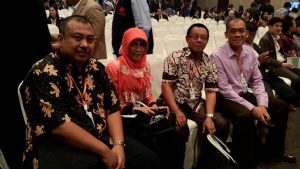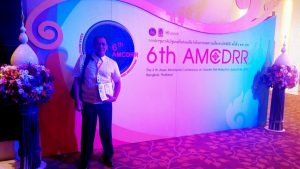By Leo L. Quintilla, CHIEF ADMINISTRATIVE OFFICER

The increasing vulnerabilities of Asian countries to natural and human-induced disasters has long been recognized. In various countries, exposure to hazards and risks are seen to be increasing due largely to the effects of climate change and challenges of development. Thus, the need for community response that is directly proportional to its capacity to mitigate disasters.
After the 2004 mega-tsunami in the Indian Ocean which devastated many countries in South and Southeast Asia, a bi-annual ministerial conference among Asian nations was begun to come up with appropriate response and recovery measures brought forth scientists, inter-governmental organizations and NGOs, academe, development agencies, business and political leaders to discuss state-of-the-art initiatives and strategies on DRR.
The development strategies needed to be innovative and informed by current advances in science and technology. There was also a great call for governments to increase investments in DRR not only to increase capacity and preparedness but to further embed investments in sustainable development.
The 6th AMCDRR in Bangkok-supported by the United Nations International Office for Disaster Risk Reduction (UNISDR) and the Royal Thai government- was a continuation of that collaborative course among Asian countries to discuss, update, and contribute to the global discourse on Disaster Risk Reduction (DRR).
Pre-conference events were scheduled to develop core messages for the high-level ministerial conference. These events gathered experts to speak on the following topics: (1) building community resilience, (2) integration of sustainable development, climate change and DRR, (3) local level actions towards DRR, (4) women as a force in resilience building, gender equality in DRR, (5) reducing exposure and underlying risk factors, (6) strengthening risk governance and accountability and (7) incentivizing DRR in the private sector. The main agenda of the conference is to come up with the Bangkok Declaration on DRR in Asia and the Pacific as an output of Asian countries and our contribution to the post-Hyogo Framework of Action on DRR to be discussed in the Global DRR conference in 2015.
I will highlight in this report the key lessons in the pre-event conference where I presented the DRR framework of Kalahi-CIDSS. This is premised on the idea that the conference is a continuing conversation on DRR and the importance of sharing innovative and good practices.
RECOGNITION OF CDD TO INTEGRATE DRR: Kalahi-CIDSS
The Kalahi-CIDSS was invited by Asian Development Bank (ADB) that organized a pre-event conference on “Strengthening Community Resilience in Southeast Asia.” In my exchange of emails with Arghya Singha Roy, the ADBCDD specialist, he said that “there is no need to convince people on CDD, what the conference participants need to know is how DRR is being integrated with CDD processes and in KALAHI-CIDSS.”
This is founded on the expectation that current interventions and policy-framework of many countries in Southeast Asia recognize the importance of strengthening community-based interventions need enabling environment and clear processes to better embed DRR concepts and strategies. This requires innovative solutions, with the potential for scaling-up and approaches to facilitate learning from and within communities, sectors, and governments.
The pre-conference event saw simultaneous conduct of sessions that tackled different DRR issues and concern. The session on Strengthening Community Resilience was full to the brim with close to 100 participants.
Yashushi Negishi, Country Director, Thailand Resident Mission, Asian Development Bank (ADB), and Charlotte Benson, ADB spoke on Strengthening Community Resilience in Southeast Asia and set the tone for the event by emphasizing the need for widening out the discussion from traditional community-based disaster risk management and adopting a wider approach to strengthen disaster resilience through community-based development interventions.
Arghya Sinha Roy presented the ADB’s engagement in strengthening community resiliency and set the purpose and expectations for the event. He emphasized ADB’s Integrated Disaster Risk Management Fund (IDRMF) established to support developing countries effort to reduce their risk, build community-based and gender focus approaches, regional cooperation and development of knowledge, tools, and capacity building of policy makers on DRR. ADB and other funding/development agencies have increased their investments in DRR and CCA to mitigate potential development impacts in Asia and the Pacific region.
The first set of presentations discussed innovative practices on community resiliency, Prong Thran presented Vietnam’s enabling environment for community participation in building typhoon resistant housing units. This highlighted community mobilization in typhoon-stricken city of Da Nang to get involved in location identification, design, and construction.
Steward Mcculloch of Vision Fund and David Korunic AXA-Care presented innovative practices on how private sectors engage in building community resiliency. In both presentations, private sectors fund NGOs as part of their corporate social responsibility (CRS) to support communities’ response and preparedness for disaster.
STRENGTHENING COMMUNITY RESILIENCE
The next set of presentations tackled the issue of strengthening community resilience and scaling-up implementation. The first to present was Dang Quang Minh of Disaster Management Center of the Ministry of Agriculture and Rural Development of Vietnam. He highlighted the scaling of Viet Nam Program on Community-based Disaster Risk Reduction supported by the ADB. Dr. Minh presentation highlighted the convergence and support of local governments in identification and relocation of flood-affected population along the Mekong River valley.
My presentation focused on strengthening community resilience through CDD citing experiences and examples from Kalahi-CIDSS. I highlighted how DRR is framed in Kalahi-CIDSS CEAC cycle and its impact on community mobilization and building disaster- responsive and resilient community sub-projects. Examples were drawn from Kalahi-CIDSS sub-projects that endured Typhoon Haiyan.
The presentation also highlighted the challenges of scaling-up and expansion, where I discussed Kalahi-CIDSS preparations and innovations in KC-NCDDP- how the project conceptualization was informed with the aftermath of Typhoon Haiyan (Yolanda).
During the open forum, Mr. Jhapper Singh Vishokarma from the Nepal Ministry of Education, asked about Kalahi-CIDSS strategies that ensured local community contribution in building schools. I emphasized that in CDD approach, the community identifies their development issues and participate in the planning, budgeting and implementation as well as mobilizing community resources to come up with projects and other needs to respond to challenges and needs of their community. Kalahi-CIDSS emphasize cultural practices of sharing and support –“bayanihan,” “tawili”and “daguiao” which also promote a sense of community ownership.
The recognition of CDD as a viable approach in building community resilience is further supported with the presentation of PNPM-Indonesia, which highlighted how the program managed resources from international donors and their challenges in the scaled-up operations.
The next set of presentations focused on facilitating peer-to-peer learning for strengthening community resilience. Marqueza Reyes presented the work of ASEAN on DRR highlighting sharing of information among ASEAN countries and coming up with protocol on quick response and inter-country support. This was piloted in the Philippines and Vietnam as part of the ASEAN response to Typhoon Haiyan. Amnat Barlee, of Thai Crescent Society, presented how peer-to-peer learning among National Red Cross societies in Southeast Asia are coordinated and shared to better position Red Cross societies respond to disaster. Huairou Commission presented their work in collaboration with DAMPA-Philippines on facilitating peer-to-peer learning among grassroots women organization.
 The pre-conference wrapped-up with the review of policy and practice supporting community resilience that was presented and facilitated by Sanny Jegillos of UNDP. Arghya Sinha Roy summed up key discussion points as an input to the technical session for the high level ministerial conference the following day.
The pre-conference wrapped-up with the review of policy and practice supporting community resilience that was presented and facilitated by Sanny Jegillos of UNDP. Arghya Sinha Roy summed up key discussion points as an input to the technical session for the high level ministerial conference the following day.

